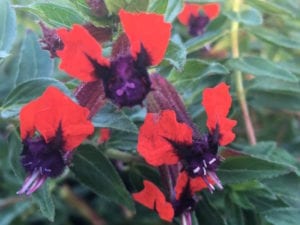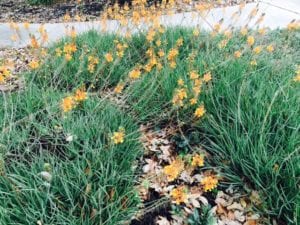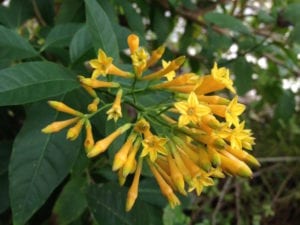This year we have been blessed with extra rain during summer, but most of us remember how dry and hot it normally is this time of year. It’s a given that our dry, hot, summers are bound to return. If you’re tired of flowers fading with the onset of heat, you are not alone. Read on for suggestions of reliable plants that offer outstanding color, regardless of how hot it gets.
5 Favorite Heat Loving Plants with Flowers
Batface Cuphea: Batface cuphea grows an average of 2′-3′ in height and width, depending on growing conditions. Considered a tender perennial, batface cuphea puts out tons of flowers from spring to fall. One look at the flowers and you’ll see why how this plant got its name. Two red petals flank a little scrunched up purple center and it literally looks like the face of a cute little bat. Batface cuphea thrives in full sun is drought tolerant once established. Offer supplemental water when extreme temperatures are present for best flowers. Plant in well-draining soil so that in times of heavy rain it will not develop root rot.
Bulbine: Bulbine has quickly become a favorite summer bloomer here in San Antonio. Bulbine grows in clumps about 2′ x 2′ high and wide. Slender, succulent-type foliage is topped with either yellow or orange flowers from mid spring to late fall. Pollinators visit gardens often when bulbine is planted. This perennial is hardy to about 20°F. Plant in sun to part sun. Well-draining soil is a must. Bulbine is easy to propagate by digging and dividing clumps. This plant looks great in rock gardens, xeriscape gardens and anywhere you want a splash of sunshine color.




Orange Cestrum: If you’ve never tried growing orange cestrum, I can say without a doubt that you’ve been missing out. This beautiful specimen produces tons of gorgeous, yellow-orange clusters of flowers and offers a delightful fragrance during evening hours. Orange cestrum loves the heat of our summers, is deer resistant, AND gives blooms from spring to frost. Orange cestrum grows about 6′ x 6′ tall and wide. Small, but plentiful, tubular flowers bring in butterflies and hummingbirds like crazy. Extra cold winters will most likely cause orange cestrum to die to the ground but return from roots in spring. When we have mild winters, cestrum will remain evergreen.
Duranta: Gorgeous, purple flower clusters drip from arching foliage on this subtropical perennial. Duranta can grow to heights of 12′-15′ depending on growing conditions. Container planting keeps plant somewhat smaller. Once the heat sets in during mid summer duranta really puts out the flowers. These blooms conicide nicely with the timing of the fall migration of our San Antonio pollinators. Butterflies are extremely attracted to the nectar-filled flowers and birds go nuts over its yellow berries. Duranta is hardy in zone 10-11 (not quite our 8b-9a) so will need to be protected in winter or think of using it as an annual.




Narrowleaf Zinnia: All summer long, you’ll be greeted with a sea of orange, yellow or white, 1 inch flowers. Low-growing narrowleaf zinnia look great planted in mass in garden beds or as the “spiller” specimen in a container. No need to deadhead the flowers like on traditional zinnias, these narrowleaf zinnia take care of cleaning themselves. They also don’t generally get the powdery mildew issues that common zinnia develop. Offer full sun and well-draining soil for the best success. Narrowleaf zinna will reseed and greet you again if the soil is left undisturbed.
More flowering favorites for the heat
- Pride of Barbados
- Esperanza
- Tropical Milkweed
- Plumbago
- Firebush
- Lantana
- ‘Mystic Spires’ Salvia
- Vinca (Madagascar Periwinkle)
- Hardy Ice Plant
- Angelonia
~The Happy Gardener, Lisa Mulroy

